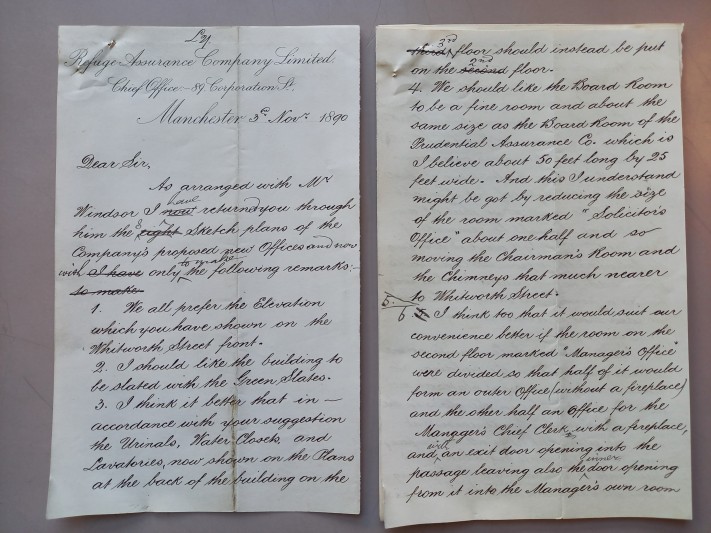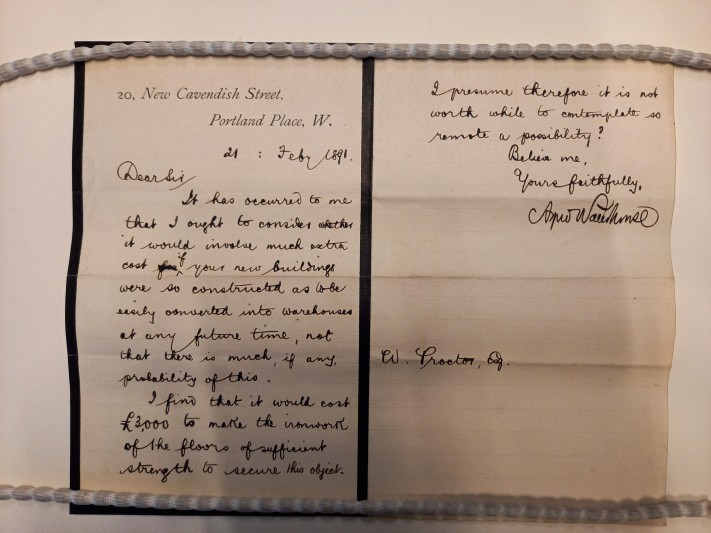Susan Pugh, Curator, writes: The RIBA is very grateful to the FNL for its generous support towards our purchase of the Refuge Assurance Company archive. We are delighted to have acquired the archive as it complements and supplements existing records within our drawings and manuscripts collections, in particular that for two past RIBA Presidents, Alfred Waterhouse (1830-1905) and his son, Paul Waterhouse (1861-1924).
The Refuge Assurance Company was founded in 1858 by James Proctor and George Robins in Dukinfield, Cheshire. It soon grew to become the major insurance company based in the North West and in 1890 Proctor employed the nationally celebrated architect, Alfred Waterhouse to design a new headquarters building in Manchester. Alfred’s son, Paul, joined him in practice in 1891 and together they completed the building design.
The archive contains a very significant collection of approximately 90 letters (dated 1891-5) between the client Proctor, and his lead architect, Alfred Waterhouse. Accompanying this correspondence are other business documents, trade press and a large collection of later papers relating to the development of the rest of the island site owned by Refuge Assurance, as they diversified their business interests by constructing packing warehouses to rent. These later structures were designed by less known, regional architects, Harry S. Fairhurst and John Dent Harker, both of whom were Associate Members of the RIBA.
The archive was offered to the RIBA through a private sale. It had been acquired in 1987 when the vendor purchased several items of furniture from the auction of the contents of the Manchester offices of the Refuge Assurance Company plc following their closure.
The Waterhouse/Proctor Refuge Assurance correspondence spans more than five years of the building project, discussing key subjects from the original purchase of the land for development and the initial building design, through to detailed aspects of its construction, fittings and furniture, and even the use of flags on the building. Proctor was very concerned with the image of Refuge Assurance and how the brand was to be portrayed on the building. A common theme through the correspondence is Proctor’s desire for the company name to be incorporated within the building’s structure. The correspondence also reveals Proctor was very aware of the rival insurance company, the Prudential. The ‘Pru’ had offices across the country, which, significantly, had also been designed by Waterhouse.
Although the RIBA holds a major collection of Waterhouse drawings and manuscripts, (over 20,000 items for structures across the UK, including Prudential offices), there was nothing previously for the Refuge Assurance building, which was one of Waterhouse’s major schemes within Manchester, the city in which he first began practicing architecture. The file of correspondence between Waterhouse and his client will therefore be a great addition to the RIBA’s holdings, complementing its existing collection for the architect, which is one of our most requested collections by readers in our Study Rooms. The archive will also hold great interest for researchers in architectural, social and economic history. It will be of particular use for research in to the evolving notion of corporate identify expressed through buildings. Furthermore, it is potentially an excellent resource for business historians interested in how a provincial business (Refuge Assurance) could learn lessons from one with a national spread (the Prudential), as well as showing how an insurance company boosted its income from premiums by investing directly in commercial development on its own property.

